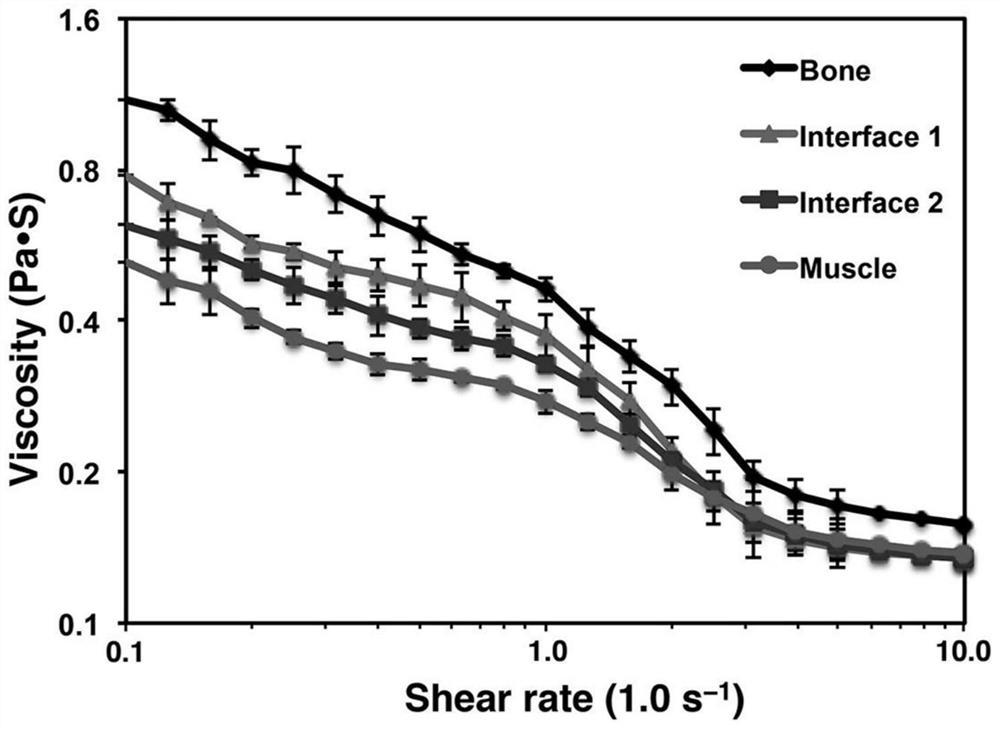Preparation of biomimetic skeletal muscle composite tissue by multi-channel extrusion 3D bioprinting
A bioprinting, composite tissue technology, used in tissue regeneration, animal cells, prostheses, etc., can solve problems such as inability to combine, provide bone lesions, and muscles have no function.
- Summary
- Abstract
- Description
- Claims
- Application Information
AI Technical Summary
Problems solved by technology
Method used
Image
Examples
Embodiment 1
[0066] A bionic skeletal muscle composite tissue prepared by multi-channel extrusion 3D bioprinting, prepared by the following preparation method:
[0067] S1. By dropping MA into the gelatin aqueous solution, the substitution degree of MA in the bionic bone was 81.4%; the bionic periosteum was 19.7%; the bionic sarcolemma was 19.7%; the bionic muscle was 19.7%.
[0068] S2. The concentration of GelMA in the bionic bone is 7.0% ( W / V ), the concentration of SA is 0.5% ( W / V ) and a gelatin concentration of 3.0% ( W / V ); the concentration of GelMA in the bionic periosteum scaffold was 5.0% ( W / V ), the concentration of SA is 0.5% ( W / V ) and a gelatin concentration of 2.0% ( W / V ); the concentration of GelMA in the biomimetic sarcolemma scaffold was 5.0% ( W / V ), the concentration of SA is 0.5% ( W / V ) and a gelatin concentration of 2.0% ( W / V ); the concentration of GelMA in the bionic muscle scaffold was 5.0% ( W / V ), the concentration of SA is 0.5% ( W / V ) and a g...
Embodiment 2
[0075] A bionic skeletal muscle composite tissue prepared by multi-channel extrusion 3D bioprinting, prepared by the following preparation method:
[0076] S1. By dropping MA into the gelatin aqueous solution, the substitution degree of MA in the bionic bone is 90.0%; the bionic periosteum is 25.0%; the bionic sarcolemma is 25.0%; the bionic muscle is 25.0%.
[0077] S2. The concentration of GelMA in the bionic bone is 6.0% ( W / V ), the concentration of SA is 0.5% ( W / V ) and a gelatin concentration of 3.0% ( W / V ); the concentration of GelMA in the bionic periosteum scaffold was 4.0% ( W / V ), the concentration of SA is 0.5% ( W / V ) and a gelatin concentration of 2.0% ( W / V ); the concentration of GelMA in the biomimetic sarcolemma scaffold was 4.0% ( W / V ), the concentration of SA is 0.5% ( W / V ) and a gelatin concentration of 2.0% ( W / V ); the concentration of GelMA in the bionic muscle scaffold was 4.0% ( W / V), the concentration of SA is 0.5% ( W / V ) and gelatin ...
Embodiment 3
[0084] A biomimetic skeletal muscle composite tissue prepared by multi-channel extrusion 3D bioprinting is prepared by the following preparation method:
[0085] S1. By adding MA to gelatin aqueous solution, the substitution degree of MA in bionic bone is 81.4%; bionic periosteum is 19.7%; bionic sarcolemma is 19.7%; bionic muscle is 19.7%.
[0086] S2, the concentration of GelMA in the bionic bone is 7.0% ( W / V ), the concentration of SA is 0.5% ( W / V ) and gelatin at a concentration of 4.0% ( W / V ); the concentration of GelMA in the biomimetic periosteal scaffold was 5.0% ( W / V ), the concentration of SA is 0.5% ( W / V ) and gelatin at a concentration of 3.0% ( W / V ); the concentration of GelMA in the bionic sarcolemma scaffold was 5.0% ( W / V ), the concentration of SA is 0.5% ( W / V ) and gelatin at a concentration of 3.0% ( W / V ); the concentration of GelMA in the bionic muscle scaffold was 5.0% ( W / V ), the concentration of SA is 0.5% ( W / V ) and gelatin at a con...
PUM
 Login to View More
Login to View More Abstract
Description
Claims
Application Information
 Login to View More
Login to View More - R&D
- Intellectual Property
- Life Sciences
- Materials
- Tech Scout
- Unparalleled Data Quality
- Higher Quality Content
- 60% Fewer Hallucinations
Browse by: Latest US Patents, China's latest patents, Technical Efficacy Thesaurus, Application Domain, Technology Topic, Popular Technical Reports.
© 2025 PatSnap. All rights reserved.Legal|Privacy policy|Modern Slavery Act Transparency Statement|Sitemap|About US| Contact US: help@patsnap.com



